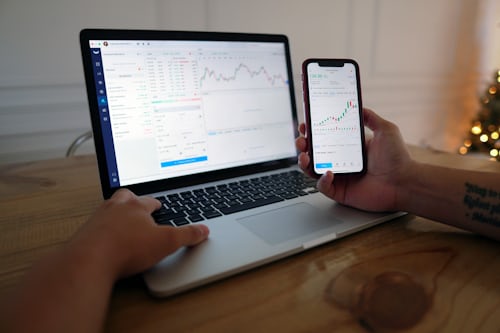With derivatives you can implement a wide variety of strategies - from extremely low-risk to highly speculative. It is also possible to use them to hedge existing positions. Whatever your market expectations and your risk appetite: There is a suitable product for it. The most popular securitised derivatives in Europe include:
Discount certificates
With discount certificates you invest in an underlying asset, for example a share, at a price discount. This provides a certain buffer against losses. In addition, the discount makes it possible to make a profit even if the market moves sideways. On the other hand, the profit potential is limited if the market develops positively. If the price rises above the so-called cap, this is of no use to you.
Reverse convertibles
Despite the name "bond", these are certificates that allow you to invest in shares. The risk-reward profile is similar to that of discount certificates. The discount is replaced by an interest payment. You get back the nominal value of the security if the underlying share is above an agreed strike price at maturity. Otherwise you receive the shares - with a corresponding price loss.
Bonus certificates
Bonus certificates also allow you to profit from stagnating prices. At the same time, they offer a certain degree of hedging and the chance to participate in rising prices. Bonus certificates have a bonus level and a barrier. If the price of the underlying asset does not touch the barrier during the term, you receive at least the bonus level. If the underlying asset rises above the bonus level, you participate in further price increases. After touching the barrier, the certificate behaves like a direct investment in the share or index.
Index and basket certificates
With these you participate 1:1 in the performance of an index or a basket of securities. The behaviour is similar to an ETF. Advantage: The costs are usually lower. Disadvantage: Index and basket certificates have a so-called issuer risk. There are also reverse index certificates that move in the opposite direction to the underlying instrument: If the market plummets, the price of the security rises.
Guarantee certificates
If you are extremely risk-averse, you can buy guarantee certificates, also known as capital protection certificates. Here you get back a fixed minimum amount at maturity in any case, regardless of the market development. However, this hedging is relatively expensive and you therefore only partially profit from a positive development of the underlying.
Leverage certificates
These include turbo certificates, knock-out certificates and mini futures, although there are certain differences in their design. CFD in exness mt5 download work in a similiar way. But all of them are highly speculative leverage products with a total risk of loss. Similar to futures on the futures exchanges, they move in line with the underlying, whereby the leverage increases profit potential and risk. Both are higher the closer the price of the underlying is to the knock-out threshold. If this is reached, the security expires. In some cases, investors still receive a residual value. Leverage products are available as long and short variants: With the former you speculate on rising prices, with the latter on falling prices.
Factor certificates
These leverage securities amplify the price changes of the underlying by a certain factor. Advantage: They do not have a knock-out threshold. Disadvantage: Unlike knock-out certificates, the leverage is constant because the factor effect always refers to the previous day's close. Due to this peculiarity, the security can lose value in nervous sideways phases with alternating up and down days, although the market does not move from the bottom line.
Classic warrants
They represent options securitised as securities and behave in the same way. With a call warrant you acquire the right to have the underlying delivered at the fixed strike price until maturity (American type) or at maturity (European type) or to receive the corresponding cash settlement. If the market price at that time is higher than the strike price plus the option premium paid, the result is a profit. With the put warrant, the whole thing is reversed; it is not a call option but a put option. But beware: Other factors, especially the volatility of the underlying, have a considerable influence on the price of classic warrants. If the market does not develop as expected, there is a risk of total loss.
- 重磅官宣!开云体育携手皇马俱乐部打开数字体育领域新版图
- Mobile sports betting app from a betting company
- Types of fire-prevention products
- How to start earning in tick current
- Why are slots a good choice for beginners in the world of gambling?

